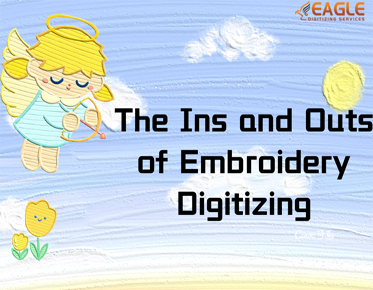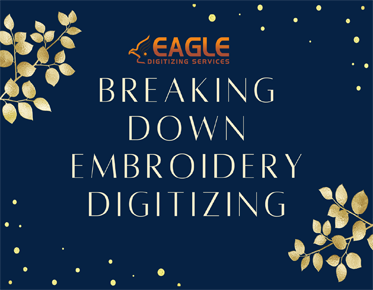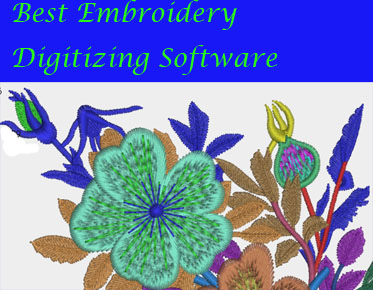The Ins and Outs of Embroidery Digitizing: What You Need to Know
Introduction to Embroidery Digitizing
Embroidery digitizing is the art of converting artwork or designs into digital formats that can be stitched onto fabric by embroidery machines. In the modern era of textile production, embroidery digitizing plays a pivotal role in creating intricate and precise embroidery designs with efficiency and accuracy. Understanding the fundamentals of embroidery digitizing is crucial for anyone involved in the embroidery industry, from designers to manufacturers.
Understanding the Basics of
Embroidery Digitizing
Embroidery digitizing involves the process of transforming two-dimensional designs into instructions that embroidery machines can interpret and execute. It's like translating a visual concept into a language that machines understand. This process enables the creation of detailed and complex embroidery designs, allowing for greater creativity and customization in the finished products.
Advantages of Embroidery
Digitizing
One of the primary advantages of embroidery digitizing is the precision and consistency it offers. Unlike traditional embroidery methods, which rely on manual stitching and are prone to human error, digitized embroidery ensures uniformity and accuracy in every stitch. Additionally, digitizing embroidery designs provides the flexibility to create intricate and elaborate designs that would be challenging or impossible to achieve manually.
Types of Embroidery Digitizing
Machines
Embroidery digitizing machines come in various types, each with its own set of capabilities and features. Single-head embroidery machines are suitable for smaller projects or custom orders, offering precise control and attention to detail. Multi-head embroidery machines are designed for high-volume production, enabling simultaneous stitching of multiple designs to increase efficiency. Computerized embroidery machines are equipped with advanced automation and digitization capabilities, allowing for precise and intricate embroidery designs.
Key Components of Embroidery
Digitizing Software
Embroidery digitizing software is essential for creating and editing embroidery designs. These software programs provide designers with a range of tools and features to input and edit designs, generate stitches, and export files for machine embroidery. Design input and editing tools allow designers to create or modify designs with ease, while stitch generation and editing features enable the customization of stitch types, densities, and sequences. File export and compatibility ensure that designs can be seamlessly transferred to embroidery machines for stitching.
Steps in the Embroidery
Digitizing Process
The embroidery digitizing process typically involves several sequential steps, each essential for achieving the desired embroidery design. Design creation or importing is the first step, where designers either draw their designs from scratch using design tools or import existing artwork into the digitizing software. Digitizing preparation involves optimizing the design for conversion into stitches, while stitch generation and editing refine the design's details and specifications. Finally, machine setup and embroidery entail transferring the digitized design to the embroidery machine for stitching onto fabric.
Factors Affecting Embroidery
Digitizing Quality
Several factors can impact the quality of embroidery digitizing, ranging from design complexity to machine calibration. Design complexity and density influence the stitch count and overall appearance of the embroidered design, requiring adjustments to achieve the desired results. Thread and fabric selection are also critical considerations, as different materials may require specific thread types or tension settings. Proper machine calibration and maintenance ensure consistent stitching quality and performance, minimizing issues such as thread breaks or stitching errors.
Common Challenges and Solutions
in Embroidery Digitizing
Despite advancements in technology, embroidery digitizing may encounter various challenges during the digitization process or stitching phase. Thread breakage and tension issues are common problems that can disrupt the embroidery process, often requiring adjustments to machine settings or thread types. Stitch distortion or puckering may occur due to incorrect tension or insufficient stabilization, necessitating troubleshooting and adjustments to achieve smooth and even stitching. Design scaling and resizing issues can also arise, requiring careful attention to detail and precise adjustments to maintain design integrity.
Best Practices for Successful
Embroidery Digitizing
To achieve optimal results in embroidery digitizing, adhering to best practices is essential. Starting with high-quality designs or artwork sets the foundation for successful embroidery digitization, ensuring clarity, detail, and suitability for embroidery. Additionally, optimizing designs for specific fabrics and thread types helps maximize stitching quality and durability, preventing issues such as thread breaks or puckering. Testing and adjusting settings before full-scale production can help identify and address any potential issues or inconsistencies, ensuring a smooth and efficient embroidery process.
Applications of Embroidery
Digitizing
Embroidery digitizing finds widespread applications across various industries and sectors, including apparel and fashion, promotional products and branding, and personalization and customization. In the apparel and fashion industry, digitized embroidery allows designers to embellish garments with intricate logos, patterns, or motifs, adding a touch of sophistication and individuality to clothing items. Promotional products and branding benefit from digitized embroidery for creating branded merchandise such as caps, bags, or corporate uniforms. Personalization and customization services utilize embroidery digitizing to create personalized gifts, monogrammed items, or customized accessories, catering to individual preferences and tastes.
Trends and Innovations in
Embroidery Digitizing
As technology continues to advance, embroidery digitizing is evolving to embrace new trends and innovations in the industry. One such trend is the rise of 3D embroidery effects, which add depth and dimension to embroidered designs, creating eye-catching textures and visual interest. Smart embroidery technologies are also gaining traction, incorporating features such as wireless connectivity, touchscreen interfaces, and automated stitching processes for enhanced efficiency and user experience. Sustainability and eco-friendly materials are becoming increasingly important in embroidery digitizing, with a growing emphasis on environmentally responsible practices and materials.
Conclusion
In conclusion, embroidery digitizing is a versatile and transformative process that enables designers and manufacturers to create intricate and detailed embroidery designs with precision and efficiency. By understanding the fundamentals of embroidery digitizing, including its benefits, key components, and best practices, individuals can harness the power of this technology to bring their creative visions to life. Whether in the apparel industry, promotional products sector, or personalization market, embroidery digitizing offers endless possibilities for adding unique touches and visual appeal to a wide range of products and projects. As technology continues to advance and new trends emerge, the future of embroidery digitizing promises to be even more innovative and exciting, opening up new opportunities for creativity and expression in the world of embroidery.
For professional and reliable embroiderydigitizing services, choose Eagle Digitizing. Our team of experienced
digitizers is dedicated to delivering high-quality results that exceed your
expectations. Contact us today to learn more about our services and how we can
help bring your embroidery projects to life.



